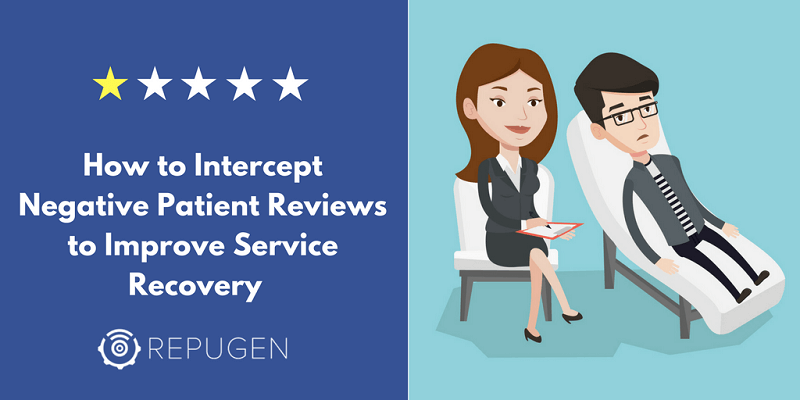
The idea of responding promptly to negative patient reviews has a positive intention of identifying and understanding patient issues as soon as they occur, and act immediately on fixing them – with a motive to regain the trust of dissatisfied patients, while also encouraging all patients to leave honest public reviews, and recover them as a patient. Negative patient reviews are bound to happen.
Potentially, even a few negative reviews can be damaging for your reputation, if they are not handled carefully. More than that, a negative review also means a dissatisfied patient who needs to be taken care of.
By listening to your unhappy patients' concerns and solving their issues, you not only address the issue quickly, but also regain the trust of your dissatisfied patients and turn them into your most loyal promoters.
Generally, this whole process is carried out under a defined patient service recovery program in any healthcare practice.
FTC Note: All patients, regardless of sentiment, must receive the same opportunity to post a public review. Service recovery should complement, not replace, open feedback.
According to Agency for Healthcare Research and Quality (AHRQ), service recovery is the process used to "recover" dissatisfied or lost patients by identifying and fixing the problem or making amends for the ‘failure’ in customer or clinical service.
In simple terms, it's about listening to your patient's problems, understanding their issue, fixing it, regaining the lost trust, and finally turning your unhappy patient into a loyal promoter.
Patient service recovery starts with having a complaint management system that allows patients to register their complaints. Receiving a complaint is the most traditional way of knowing about the unhappiness of your patients. Keep in mind that the chances of success are higher in service recovery when it is done immediately after the patient has expressed distrust or unhappiness.
That's exactly why healthcare providers are increasingly using review monitoring tools to improve their patient recovery rate. These are not actually separate systems, but a part of the online reputation management process, which helps by:
This kind of proactive approach towards patient recovery helps in solving the patients' issues as immediately as they occur.
Review monitoring tools are a great way for providers to identify and analyze negative reviews.
The process for how this tool helps a provider identify and respond to negative feedback is simple.
1. You send a review invitation, including links to public review sites, to your patients shortly after their visit. Even if the feedback is negative, the patient still sees the same review site links as every other patient.
2. Your patient writes about his/her experience and also rates your quality of service.
3. If the submitted review turns out to be negative, your practice manager will immediately get notified about it.
4. Your practice manager will understand the issue by reading the submitted review, and take the required action for complaint redressal (if needed, your practice manager will involve you in this). The complaint redressal process should go as follows:
This is in compliance with the process as laid down by the AHRQ (See the screenshot below): 
Source: AHRQ
Steps 1, 2, and 3 talk more about the immediate strategies related to complaint redressal, while steps 4, 5, and 6 are more about the strategies related to using a database of reviews to track and improve the performance of your practice or hospital and its staff, and about how to eliminate the causes of lower patient satisfaction. [Online reputation management tools help in this too]
5. After service recovery, the tool may prompt the patient again to leave a review, just as every patient is invited to do, regardless of their experience (which they can directly post on the review website they choose) Here's how RepuGen (a HIPAA compliant online reputation management software) identifies and flags critical feedback for timely follow-up, and lets you conduct service recovery for improved patient retention:
While using these tools, the only thing that you'll need to take care of is to keep the patient identity or patient health information publicly undisclosed, and you'll never have to face any compliance issues from HIPAA.
3 out of every 4 cases of negative reviews of doctors and clinics are about wait times, grumpy receptionists, parking, etc. Only 25% of the cases are from providers' side, such as bedside manners, proper communication about medicines and treatment, etc.
However, that doesn't mean service recovery is the sole responsibility of your front-line staff. “Your front-line staff, to whom patients usually address those complaints, do not necessarily have the skills or resources to fix ’system issues‘ that are often the source of the problem,” says Dr. Wendy Leebov, a national expert on service recovery in healthcare.
According to Dr. Leebov, managers and the executive leaders have responsibility for redesigning dysfunctional work processes and systems, or reassigning staff if needed.
Responding to critical patient feedback is just the start of the service recovery process. After having identified your unhappy patients and having understood their cause of concern, the next step is to get your team together in solving that issue and recovering the unhappy patient. After all, a strong base of loyal patients is all that your healthcare practice requires for long-lasting success. By ensuring all patients are invited to leave public reviews, and following up promptly, you build trust and transparency in your healthcare practice.
0 Comment
Your email address will not be published. Required fields are marked *